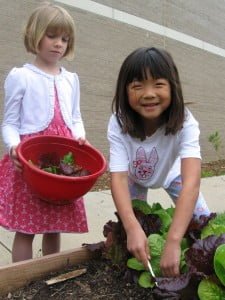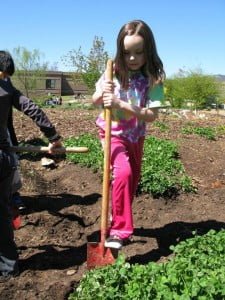1. Start early. Make plans for your spring garden in January. Think about where and what you’re going to plant, as well as resources in your community. Who might donate a few seed packets? Who could help with preparing the seed bed if your students aren’t old enough? You may want to contact your local high school or community college. Students in Agriculture programs could potentially offer labor, plants and/or planting advice. Local Garden Club members or Master Gardeners can often offer their time to give you an extra hand.
2. Start small. The first year that you garden with your students, don’t feel pressure to have a big harvest. Start with a small space, turning over the soil with a shovel. To reduce weeds remove grass and roots as you turn the soil or cover it will plastic for a month before hand. Most soils that sustain grass are fine for growing vegetables. You may want to incorporate some compost or other amendments into the soil if available. You don’t have to plant lots of different vegetables. Classroom gardens should be more about the experience and magic of growing rather than what is produced. A small successful project is something you can build on each year.
3. Send home a wish list with your students. Many parents have old tools lying around that they don’t use or would be happy to donate seeds, gloves, compost, mulch, etc.
4. Tell teachers and administration about what you are doing. Showing your school’s administration and other teachers how you are tying the garden into curriculum will build support and encouragement. You might even inspire others to get involved!
5. Choose a few things to plant: The following are a few examples of “cool season vegetables”, which can be directly seeded outside in March or April (or in August/September for a fall garden):
 Lettuce
Lettuce- Chard
- Radishes
- Collard greens
- Mustard greens
- Carrots
- Kale
- Spinach
- Peas
- Spring Mix
- Beets
- Potatoes
All of these veggies should be ready to harvest (except potatoes, which are dug in the late summer/fall) before school lets out!
The following fruits and vegetables are examples of “warm season” plants, and can be planted in May, after the danger of frost has passed. Make sure to check the seed packages, because many warm season plants (such as tomatoes and peppers) need to be started indoors or purchased as transplants. Most of these items will not be ready to harvest until the summer or fall:
- Tomatoes
- Beans
- Peppers
- Squash
- Melons
- Pumpkins
- Zucchini
- Gourds
- Eggplant
6. Get a good start. Some types of plants need to be started indoors weeks/months before they can be planted outside. Most seed packages will give you a recommendation as to when seeds should be planted and if they need to be started indoors. If you have good light or grow lamps you and your students can plant “starts” beginning in February. If you don’t start seeds yourself, you can buy starts at area tailgate markets or greenhouses beginning in April. We have a lesson plan with step-by-step instructions for planting starts.
7. Plan for upkeep. Depending on the size of your garden, mulching and weeding can be more than young kids can take care of. If you find that you have more upkeep than you and your students can handle, ask a parent or community volunteer to come in occasionally to help. If you plant summer or fall crops, you may want to enlist a family or volunteer to help maintain your plot over the summer. If not, a weedy garden can be a great source of adventure when students return to school. When it doesn’t rain, make sure to water thoroughly at least once per week so that soil always stays moist.
8. Create a routine. Established routines are great for students and gardens alike. Students look forward to “garden time” and benefit from being involved in maintenance, as well as harvesting. Having “garden time” at least once a week to plant, water, weed, or just observe will ensure your students are engaged in the growing process, and that your garden is getting the attention it needs.
9. Utilize lesson plans. School gardens are more sustainable when they are used as a teaching tool, rather than an extracurricular activity. This website includes a wide variety of lesson plans that will help you use hands-on garden experiences to fulfill standard course of study objectives.
10. Keep it fun! Students love to work in the garden, and it can be a powerful and fun way to teach concepts from early literacy to math. One look at a child engaged in the wonder of growing or eating vegetables they once scoffed at, and all of the work of planning your garden will pay off!

 Lettuce
Lettuce